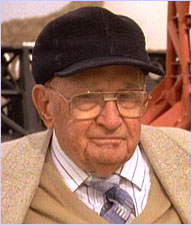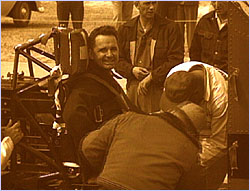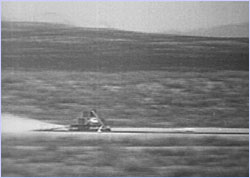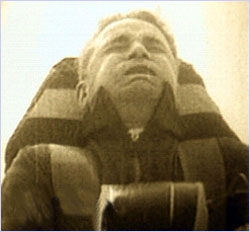
|
 |
 |
Fire | Car | Plane | Ship Dr. John Paul Stapp trained as a medical doctor and spent many years conducting and participating in crash tests for the United States Air Force, from which he retired in 1970. Since then, he has taught at the University of Southern California and has written a number of books. Stapp is a fellow in the Society of Automotive Engineers (SAE) and serves on the board of the Stapp Foundation, which is associated with the SAE. NOVA: How did the idea that a plane crash could be survivable originate? Stapp: The old idea that accidents were acts of God, and you just had to sit there and take it, whether in an airplane or a car, became obsolete when we discovered that we were losing more people in the Eighth Air Force near the end of World War II by crashes than by combat. So at a meeting in Washington in May 1945, all branches of the service agreed that we had to find these things out. The Air Force was elected to do a copycat of the crash test sled at Tempelhof Airport in Berlin—their method, but not their use of people. So the Air Force eventually took over the track at Edwards Air Force Base. NOVA: Backtrack a little for us, if you will, and tell us more about the German research at Tempelhof Airport. Stapp: In the early 1930s, the Germans were doing research on behalf of their newly revived and not necessarily legal air force, with two objectives. One objective was carrier launching of aircraft, so that they could improve sea power. The other objective was to develop and test ejection seats for fighter craft. After jettisoning the windscreen, or canopy, they could then fire the man and his seat out of the airplane. Or so they thought. At Tempelhof Airport in Berlin they created about a 50 or 60-foot tall ejection tower. The seat slid up by piston propulsion. It could be arrested on any point of the track, and the tolerance of the human spine to being kicked from below could be measured, because they didn't want any broken-backed pilots trying to escape. NOVA: So in other words, this testing wasn't operated with volunteers? Stapp: This was operated with non-volunteer human subjects. When the testing caused serious injury to the back—x-ray visible fracture or what have you—the subject was then euthanised, and they did a dissection of the spine and would take out segments of five vertebrae in an unbroken area and use static testing machines to measure the static force that would fracture the spine. They did eventually develop aircraft ejection seats that were fired by a gun. It wasn't until England became involved in World War II that the English began to develop ejection seats for English aircraft. But they did not resort to non-volunteers, and they didn't dissect anybody that I know of. NOVA: Can you tell us more about the English work in escape testing in those days? Stapp: The first use made of information from German experiments was by the Martin Baker company of England, which developed the first non-German ejection seat. And they did excellent work. They did human experiments. On a visit to Farnborough I watched the ejection of a British pilot from an aircraft on a runway at 90 miles an hour. It even worked from practically a standstill. The Martin Baker material came to the U.S. and was used in developing the first U.S. ejection seats.
Stapp: When I arrived at the Air Medical Laboratory, Wright Field on August 10, 1946, they immediately got me involved in escape research. I rode the centrifuge and I rode the ejection seat tower up and down, because willing subjects were not abundant. Six days after I arrived at the Wright Field Lab I observed the first American ejection from a Northrop aircraft, from 8,500 feet in altitude. It was a big success, using a gun catapult for firing the seat that originated in Germany and was developed at Martin Baker. All the information came to the U.S. in early 1945 and was the basis for using the German V-2 track at Edwards Air Force Base. We knew it could be done. We eventually did our own designing and developing, and we even copied their pinch brake system, which was found on this Tempelhof track. NOVA: Why were you moved to Edwards Air Force Base? Stapp: While I was at the Wright Field, they were preparing to do the experimental program at Edwards Air Force Base. Presently I found that I was appointed the subject. After all, I was a bachelor and would leave no widow if anything went badly. I was made project officer because I was a licensed physician. In addition, I had a doctorate in biophysics and had taught anatomy and physiology to physical education students. I even dissected 19 bodies in my time, including those during my medical freshman year at the University of Minnesota. So I was fairly familiar with anatomy and human physiology.
Stapp: They called Edwards Air Force the hot Siberia of the Air Force, because it was just an end-of-World War II, broken-up camp, with few conveniences. So I was sent on May 12th, 1947, to Edwards, where I found this 2,000-foot track with a set of mechanical friction brakes, 50 feet in length, at the 1,200-foot point on the track, capable of going by 5-G increments up to the limit of 55 G's. The object was to find the injury limit and survival limit by an aircraft crash simulation. And believe me, it wasn't really simulation. You don't break an arm in a simulation. NOVA: What was your assigned project? Stapp: The project that was turned over to me was a contract with a company that did all of the work of setting up and accomplishing the runs. I was the only subject available because I was a project officer in charge, and I had not been given any subordinates or assistants. So after 35 test runs with an old parachute dummy weighing 212 pounds, the track was accepted and that part of the contract was paid for, including overrun. We were all set to do the first human experiment on testing crash tolerance, on December 10th, 1947. And the only available subject was me, the project officer. I felt fairly certain that things would go well, because these 35 test runs were also my idea of training a crew to do it without flaws. I arrived at the project at about seven o'clock in the morning, and they were having coffee and donuts. They said, "Major, would you like some coffee and doughnuts?" And I said, "No, it makes a messy autopsy." That was to get them focused and serious, because you could have an autopsy.
Stapp: They put me on the sled and went through the whole drill and countdown. That's when you began to get a little adrenaline. You hear from ten counting down to one, and all of a sudden, wham, you get the biggest kick you've ever had in your life as the sled takes off. In five seconds it reached 90 miles an hour, which was the first run with two rockets. I was seated backward inside a cage—somebody's idea of a rocket sled. It came to a halt, and I came off the sled with something I later was able to identify as survival euphoria. You're there tense and waiting and getting kicked and then it's all over and you're all right. And you go away saying, "Great, I think I can take some more." NOVA: Was there any other reason why you were a subject? Stapp: Although I was a project chief, if I didn't do it, how do you think I would get some sergeants and corporals to do it? I always led off. I did the hardest ones first, and then they would repeat it. In all we did 73 experiments with humans before we finally collected the information that we wanted. And for some reason, I was the only one that got two broken wrists and cracked ribs. And on the last run, I got retinal injuries. I survived 26 sled rides on the Edwards track. NOVA: How did you decide whether the other staff should take part in the testing? Stapp: I was extremely careful in all those regards with my subjects. They were required to see a run with another trained human, usually myself, and volunteer for the proof run of 20 G's on an Edwards Air Force Base sled. And they were required to give a careful detailed report and interrogation after the experiment. They were carefully prepared. All usual medical measurements were made on them and recorded before the run, and then the same measurements were repeated after the run. NOVA: What exactly was learned from these 20 G proof runs? Stapp: That first run would tell me whether the subject was emotionally stable enough and physiologically free from hazards. For instance, after a run one subject developed tachycardia, a fast heart beat, so we disqualified him from any further slide experiments. NOVA: What was the outcome of your research, and how was it applied to escape? Stapp: We did this research for a lot of reasons, some of which turned up as side effects of the research, like taking information primarily sought for human tolerance to crashes and human tolerance to upward ejection and downward ejection. It provided standards for safety. Deciding it could be useful to use both the restraint systems and the limits of tolerance in the automotive crash protection program has saved more than 15 or 20,000 lives a year of people going through otherwise fatal crashes. The object was the opposite of making war; it was keeping people alive. Our findings were applied to both aviation and automotive transportation. I even testified at hearings that helped establish the U.S. Department of Transportation. I helped formulate the protective laws, the seat belt laws and so on and so forth. When I first went and did some serious thinking about using myself as the subject, I bore in mind that that was exactly what we were going to do—save lives by offering protection. NOVA: What would you tell a young person who is interested in going into a similar line of work? Stapp: Applied research is short order cooking, and it is necessary. You have the satisfaction of knowing it's not esoteric. It's not like classical research, just to find out something nobody can use. Applied research produces results that go into, in this case, saving lives. My parents were missionaries, so this follows a family tradition. Photos (1) NOVA/WGBH Educational Foundation; (2-4) United States Air Force. Escape Through Time | Skydive | Human Response Survivor Stories | Pioneers of Survival | Survival Strategies Resources | Teacher's Guide | Transcripts | Site Map | Escape! Home Editor's Picks | Previous Sites | Join Us/E-mail | TV/Web Schedule About NOVA | Teachers | Site Map | Shop | Jobs | Search | To print PBS Online | NOVA Online | WGBH © | Updated November 2000 |
 Dr. John Paul Stapp
Dr. John Paul Stapp
 Stapp was project chief and the first subject of
high-risk experiments that led to an increased
understanding of the human response to extreme forces.
Stapp was project chief and the first subject of
high-risk experiments that led to an increased
understanding of the human response to extreme forces.
 Cars such as these would race along tracks to
extremely high speeds, exerting a force of up to 55
G's on the passenger.
Cars such as these would race along tracks to
extremely high speeds, exerting a force of up to 55
G's on the passenger.
 Putting his own safety on the line, Stapp pushed the
limits of our understanding about the capacity of the
human body.
Putting his own safety on the line, Stapp pushed the
limits of our understanding about the capacity of the
human body.